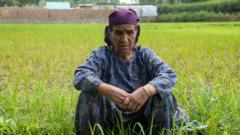The region is experiencing its highest temperatures in decades, with highs reaching 37.4C (99.32F), 7C above the normal seasonal average, impacting the livelihoods of many farmers reliant on stable weather patterns. A recent study highlights a concerning temperature rise of 2C from 1980 to 2020, driven in part by climate change. As rivers dry up and produce quality diminishes, Zaina’s family and others like Ali Mohammad, who converted their paddy fields to apple orchards years ago, are witnessing their agricultural efforts crumble.
Health concerns are on the rise too, as locals like Parveez Ahmad face severe heat-related ailments, highlighting the direct impact of these extreme conditions. Environmental experts warn of a lasting systemic change in the region's climate, exacerbated by both warming winters and increasing summer temperatures that disrupt existing patterns of rainfall and glacier melt.
While Kashmir contributes minimally to global carbon emissions, its residents now find themselves increasingly vulnerable to the global phenomenon of climate change while grappling with urbanization and deforestation that further strains the traditional climate balance. The local government insists they are taking climate issues seriously, but for many like Zaina, immediate action is essential to stave off disaster, as they face an uncertain agricultural future.
Health concerns are on the rise too, as locals like Parveez Ahmad face severe heat-related ailments, highlighting the direct impact of these extreme conditions. Environmental experts warn of a lasting systemic change in the region's climate, exacerbated by both warming winters and increasing summer temperatures that disrupt existing patterns of rainfall and glacier melt.
While Kashmir contributes minimally to global carbon emissions, its residents now find themselves increasingly vulnerable to the global phenomenon of climate change while grappling with urbanization and deforestation that further strains the traditional climate balance. The local government insists they are taking climate issues seriously, but for many like Zaina, immediate action is essential to stave off disaster, as they face an uncertain agricultural future.



















